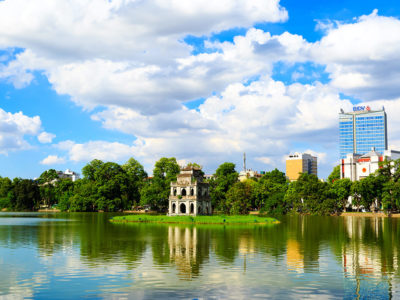Laos Travel Tips: A Day in the Life of a Novice Monk in Laos
The most remarkable thing visitors notice when travelling to Vientiane or Luang Prabang in Laos, are the throngs of saffron-clad monks wandering about the streets. It is estimated that about 1 in 3 male Laotians become monks for at least some period of their lives, ranging from a few months or years to an entire lifetime. Most novices enter monastic life at an early age, learning the ancient chants and sutras, while also attending a regular school with a modern curriculum similar to that followed by most young children and adolescents.
For many children in rural areas of Laos, joining a monastery is the only available option for education. Life in the monasteries can be tough and some novices from remote communities are only able to visit their families once or twice a year, if at all. The novices follow a strict daily routine, living communally, sharing food and daily chores, while also attending school, observing religious practices and performing tasks such as helping with the upkeep and restoration of temple and monastery structures.
We asked some former and current monks about their experiences as novices and reconstructed a day in the life of a novice monk in Laos. While many aspects of monastic life may still seem old-fashioned and austere, some influences of modernity have managed to seep into the ancient monasteries, with sugary snacks and mobile phones playing an ever increasing role in the lives of these child monks.
Life of a Novice Monk in Laos
For most children living in remote villages, without access to schools, becoming a novice at a young age is the only way to get an education.
Rise and Shine
The novices have to get up bright and early at 4 a.m. to attend communal chanting and prayers. Learning the complex sutras and ancient holy texts of Theravada Buddhism is quite difficult, and prayers must be performed precisely and without fault. After chanting, the young monks must take to the streets to beg for their daily food. In Luang Prabang, the monks and novices leave the monastery at 5 a.m., walking in a long procession to receive offerings of sticky rice, fruits and other foods in their alms bowl.
The novices eat communally and share from the alms they were given. They will usually only eat twice a day, a meal mostly consisting of sticky rice, but many novices consider the food much more nourishing and varied than what they received in their home towns. One former monk we talked to said that young novices were also permitted to eat some meat, and those with families nearby would often sneak some food on their short daily visits to meet with relatives.
Malte Blas - Life of a Novice Monk in Laos
Novices and monks of all ages line up early in the morning to receive alms in Luang Prabang. The alms consist of traditional sticky rice, fruits, vegetables, as well as snacks and candy.
School and Chores
After breakfast, the young novices attend school. These schools are very similar to those attended by other children, with many of the classes taught by senior monks. There are also many foreigners teaching at these schools, so that guests to monasteries are often struck with the language proficiency of the monks, many of whom speak English, French, German or other languages. These foreign teachers often instruct the novices while they themselves study Buddhist scriptures, as a form of exchange.
After school, the novices must perform chores such as washing, cleaning, sweeping or other tasks relating to the upkeep of monasteries and temples. Adolescents will sometimes learn a trade, which is useful to the community but can also provide work after they leave monastic life. Many of the former monks we talked to were not only well versed in Buddhist scripture, spoke several languages, had extensive experience in a trade such as carpentry, but had also attended or were planning to attend university overseas.
Malte Blas - Life of a Novice Monk in Laos
In addition to school, chores, meditation and prayer, young monks are often expected to participate in construction or other tasks related to the upkeep of the monasteries and temples.
Homework and Leisure
At 6 p.m. the young novices will attend group meditation and prayers, usually lasting around two hours. Afterwards, they will need to finish their homework before going to bed. Older novices are expected to help the younger ones. Some former monks said that they would often go to bed hungry, but that this was to help them prepare for life as a fully-fledged monk, who often practice strict regimes of fasting and meditation.
These days, many of the young monks have mobile phones or tablets and are able to communicate with their families at home, some of the novices come from as far away as Thailand or China, or engage in less spiritual activities such as playing computer games. However, it is important for the novices to finish their homework, wash and prepare for bed as early as possible, as they will have to be up by 4 a.m. again the next day!
Other Article:
- Laos Travel Tips:Top 10 Must-See Destinations in Laos
- Cambodia Travel Tips: Top 10 Attractions in Cambodia
- Vietnam Travel Tips: 5 Reasons You Should Visit Cu Chi Tunnels
- Laos Travel Tips: Visit Laos' 8 Most Unique Wats & Pagodas
- Cambodia Travel Tips: 5 (More) Things to See and Do in Siem Reap
- Vietnam Travel Tips: Expert Travel Guide for Northern Vietnam
- Vietnam Travel Tips: Life Along the Mekong - The Cham Village
- Vietnam Travel Tips: A Beginner's Guide to Vietnam's National Day
- Laos Travel Tips: 7 Things to Do in Vientiane
- Laos Travel Tips: 5 Best Restaurants in Luang Prabang
- Cambodia Travel Tips: Top 10 Temples In Cambodia
- Cambodia Travel Tips: Making the Most of the Angkor Temples
- Vietnam Travel Tips: What You Need To Know





